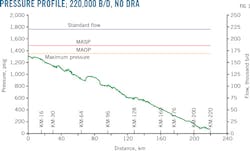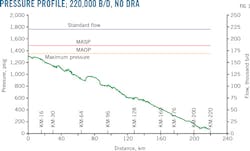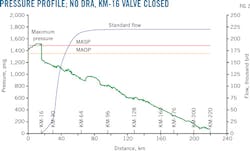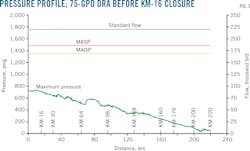DRA mitigates surges in liquids pipelines
Nazar Al-Nasr
Abbas Al-Hashim
Mustang-HDP
Al-Khobar, Saudi Arabia
A simple approach mitigates pressure surges in liquid-service pipelines without mechanical means such as surge relief systems (valves and tanks) or relying on instrumentation such as high-pressure pump trips or high-integrity pressure protection systems (HIPPS). The approach uses drag reducing agent (DRA) to lower the pipeline's pressure profile, preventing the surge pressure of a sudden pipeline-valve closure or trip of an intermediate pump station from reaching maximum allowable surge pressure (MASP).
The approach could also be applied to increasing an existing pipeline's capacity or derating its pressure to a lower maximum allowable operating pressure (MAOP) and hence a lower MASP.
Standards
International engineering standards such as ASME B31.4 and ASME B31.3 require protection against over-pressure and pressure surges for a maximum of 10% and 30% above MAOP in cross-country pipelines and in-plant piping, respectively. Some local engineering standards of surge relief protection systems apply more stringent constraints by limiting maximum surge pressure rise above MAOP to 10% for both cross-country and in-plant piping, and by restricting surge protection to only mechanical and instrument-independent means.
This article proposes a non-instrumental, non-mechanical means of pipeline and piping protection against over-pressure and pressure surge using DRA, also known as flow improvers. Such chemicals are long-chain polymers with very high molecular weights made of alpha olefins.1 Recent developments in DRA synthesis and trials show promising results in reducing frictional losses and improving multiphase flows2 even in gas pipelines (OGJ, June 5, 2000, p. 54). These results are in addition to DRA's already well-established effects in single-liquid flows such as stabilized crude or refined products.
Using DRA reduces pipeline flow turbulence and hence frictional pressure drops, thus lowering the pipeline pressure profile and eventually providing a safe margin for pressure rises and surges not to exceed a pipeline's MASP. Applying the approach to an actual pipeline via dynamic pipeline simulator confirms this claim.
Case Study
A 24-in. OD ANSI-Class 600 multiproduct pipeline carries 220,000 b/d of refined products such as gasoline and diesel from a shipper pump station in a tank farm to receiving tanks 220 km away. Hydraulics study and surge analysis showed that the pipeline needed more than one surge relief station to mechanically protect it against pressure surges caused by sudden closure of remotely operated main or emergency isolation valves (MIV/EIV).
Sudden closure of the MIV at KM-16 created the worst surge case. But applying the proposed DRA keeps pressures below MASP, protecting the pipeline from over-pressure and pressure surges.
Fig. 1 shows pipeline pressure and flow profile without DRA. Fig. 2 shows pipeline pressure profile exceeding MASP following MIV closure at KM-16 without DRA or surge relief valves.
Injecting 75 gpd of DRA (8 ppm by volume) just downstream of the shipper pumps and pressure control valves (PCV) reduces the pipeline's pressure profile by about 60%, within the effective drag reduction limit of the vendors' DRA performance.
Fig. 3 shows DRA's effect on pipeline pressure profile. Inlet pressure dropped from around 1,330 psig before DRA injection to about 800 psig after. The pressure drop across the PCVs increased as a result, the pump discharge pressure and head still following the pump performance curve, but with the pipeline system-inlet pressure lowered by DRA.
The PCV differential increased from about 20 psi before DRA injection to almost 600 psi after DRA injection (Fig. 4). This waste of energy suggests re-design of the shipper pumps and control valves to give lower discharge, head, and differential pressures, lowering required power.
Closing the MIV at KM-16 after effective DRA use shows that maximum surge pressure does not cross MASP (Fig. 5).
This approach can be applied to pipeline design, clearly showing the lower pumping requirements in comparison with the usual design without DRA. But cost analysis would have to compare the design without DRA to design with DRA, considering the fixed and operational costs of pumps, surge relief systems, and DRA skids with DRA solutions.
Even when not made part of new-build operational design, the use of DRA to reduce surges could be applied retroactively to existing systems when an emergency requires increasing pipeline flow without adequate mechanical surge protections in place.
References
1. Al-Nasr, N.., "Evaluation of Pipeline Drag Reducing Agent (DRA)," P&CSD Newsletter, Saudi Aramco, 2008.
2. Jubran, B.A., Zurigat, Y., and Goosen, M.F.A., "Drag Reducing Agents in Multiphase Flow Pipelines: Recent Trends and Future Needs," Petroleum Science and Technology, Vol. 23, No. 11-12, November 2005, pp. 1403-24.
The authors
Nazar Al-Nasr ([email protected]) is surge analysis consultant in the process department, Mustang-HDP, Al-Khobar, Saudi Arabia. He also served for 6 years as a mathematics instructor and assistant professor at King Fahd University of Petroleum & Minerals, Dhahran, and for 27 years with Saudi Arabian Oil Co. in oil and gas projects, training simulators, and pipeline hydraulics and surge analysis simulation. He holds a Ph.D (1981) in mathematics from Clarkson University, Potsdam, NY. He is a member of the American Mathematical Society and the Saudi Council of Engineers.
Abbas Al-Hashim ([email protected]) is a process engineer at Mustang-HDP, Al-Khobar, Saudi Arabia. He has also worked as a process engineer for Mustang in Houston. He holds a BS in chemical engineering technology from Jubail Industrial College, Saudi Arabia. He is a member of the Saudi Council of Engineers.






